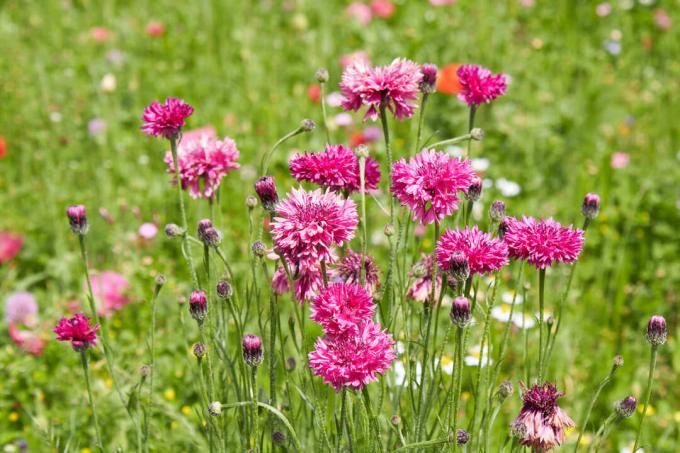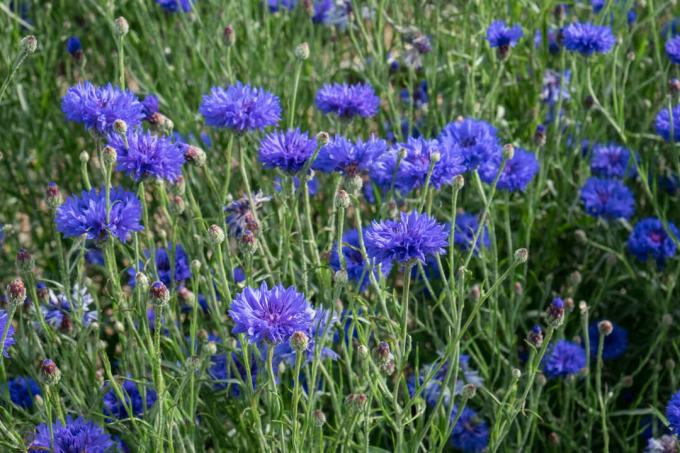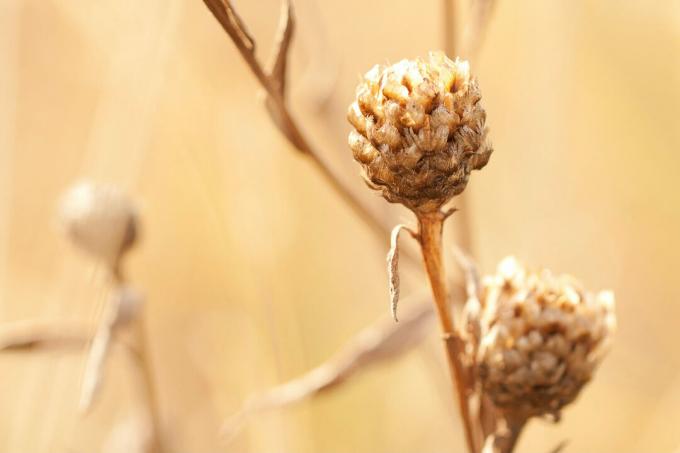The cornflower not only provides food for many insects, but is also popular in the kitchen. Their valuable ingredients can help against various ailments.

The cornflower (Cyanus segetum) usually inspires with its bright blue flowers, but can also bloom in other colors. We present the most beautiful varieties and give helpful tips on sowing, care and use.
contents
- Cornflower: flowering time, origin and characteristics
- The most beautiful varieties
-
Sowing and planting cornflowers
- The right location for cornflowers
- Instructions for sowing cornflowers
- Proper care
- Propagate cornflowers
- Are Cornflowers Edible?
- Effects and uses of the cornflower
Cornflower: flowering time, origin and characteristics
The blue flowers of the cornflower are known to most. They are often found together with the poppy in parks or in flower strips next to grain fields. Since it used to like to grow in the middle of the field, the name of the cornflower is probably not far-fetched. The cornflower is in bloom from May to September and you can enjoy its striking, but odorless flowers. These are often visited by bees and insects. The plant, also known as Zyane, only seldom grows in the field today. But is that why cornflowers are protected? No, although cornflowers are on the warning list on the Red List, they are not yet legally protected.

The annual, herbaceous plant originally comes from the Mediterranean area and with the help of humans has spread to Central, Eastern and Western Europe. It belongs to the daisy family (Asteraceae), formerly belonged to the genus Knapweed (Centaurea), but now forms the genus of bluebells (Cyanus). The cornflower grows upright and has variously shaped leaves that are covered with downy hairs. Upper cornflower leaves are usually entire and lanceolate, while lower leaves are serrated and divided. Cornflowers can grow up to 90 cm and are available in different varieties for the garden. Since the cornflower contains ingredients such as flavonoids, tannins and bitter substances, it was used as a medicinal plant in the past. Today it is sometimes still used in the kitchen, where the flowers are mainly used to decorate dishes.
Are cornflowers perennial? No, cornflowers are annuals, so they won't sprout again in the next year. By self-sowing, however, the cornflowers multiply in suitable locations and new plants emerge.

Confusion of Cornflowers: The various representatives of the knapweed (Centaurea) look relatively similar to the cornflower. However, knapweeds have wider, mostly incised leaves. The common chicory (Cichorium intybus) looks a bit like the cornflower. However, if you look closely, it can be recognized by the differently shaped small flowers.
The most beautiful varieties
There are some garden varieties of cornflower that convince with their different colored flowers. We present some of them here:
- Cyanus segetum "Blue Ball": This variety comes in the classic cornflower blue and has double flowers that appear even more lush. It can reach heights of 80 cm. However, filled varieties such as Blue Ball ’are unfortunately less bee-friendly.

- Cyanus segetum "Classic Romantic": You get several colors in one flower with the Classic Romantic ’variety. The flowers are patterned pink and white, sometimes with a higher proportion of white, sometimes with more pink in the flower. The height is 60 - 90 cm.

- Cyanus segetum ‘Red Lola’: A pink cornflower is the ‘Red Lola’ variety, which can grow up to 80 cm.

- Cyanus segetum "Black Ball": The dark red-violet of the cornflower ‘Black Ball’ appears almost black. At around 60 cm, it remains a bit smaller than most other varieties.

- Cyanus segetum 'Blue Boy': The cornflower Blue Boy ’blooms in a strong blue and has full flowers. It becomes 50 - 70 cm high.

Sowing and planting cornflowers
Cornflowers are a real eye-catcher in the garden and also easy to care for. The easiest way to establish cornflowers is to sow them.
The right location for cornflowers
A suitable location for the cornflower is sunny and not too rich in nutrients. The soil should be loose, well-drained and, if desired, slightly calcareous. The cornflower can also cope with sandy soils.
Cornflowers in mixed culture: Optically and also in terms of location requirements, fit Corn poppy (Papaver rhoeas) or daisies (Leucanthemum) excellent with cornflower. Since the cornflower is a magnet for beneficial insects, it is often part of Seed mixtures for flower meadows.

Instructions for sowing cornflowers
Since the cornflower is not perennial, it has to be re-sown every year unless it seeds itself. Sowing cornflowers is very easy:
- Apply seeds between March and April
- If the seeds are sown later, the plants will remain smaller
- Sow in small groups of around 3-10 plants
- Maintain a planting distance of about 30 cm
- Cover the seeds only lightly with soil, as the cornflower is a light germinator
- Germination after about 14 days
Cornflowers in the pot: Cornflowers can be kept in pots, for example in the balcony box, without any problems. Since the cornflower develops a very deep root, the pot should be at least 30 cm high. In addition, a drainage layer is essential so that the water can run off properly. You can make these from potsherds, expanded clay or pebbles. As a substrate, it is best to use high-quality potting soil mixed with a third of sand. Our base, for example, is suitable Plantura organic potting soilthat has a high humus content and can store water very well. In addition, it does without peat and, thanks to its natural ingredients, is also no problem for pets and garden animals. The expanded clay content in our earth also benefits the cornflower, as it increases its permeability. But you are welcome to mix in more expanded clay, then the cornflower feels all the more comfortable.
Proper care
Since the cornflower is easy to care for, there is actually not much left to do in suitable locations after successful germination.
The cornflower usually gets along very well in conditions that are quite poor in nutrients and does not require any additional fertilizers. Only in special cases, i.e. on very poor locations or in the tub, when the cornflower grows in very old or reused potting soil, is fertilization shortly before flowering useful. In this case, use a complete fertilizer that provides all the nutrients, such as ours Plantura organic universal fertilizer. Our fertilizer not only supports your plants, but also the life in the soil. A weak dosage is sufficient for the cornflower. Incidentally, over-fertilization is indicated by a lack of flowering or by slack leaves. In addition to spider mites and aphids, overfertilization is the most common cause of sick cornflowers.

Tip: In representatives of the composites, the flower head consists of many small individual flowers, which, however, are often mistaken for simple petals. The outer flower ring is sterile, only the central tubular flowers are fertile.
You only need to water the cornflower in prolonged dry periods or in midsummer. Avoid waterlogging, especially with plants in pots, and make sure that the water can drain off easily.
Cutting back is not necessary, but you can get the cornflower to flower again by removing the dried inflorescences.

Are cornflowers hardy? Cornflowers are not hardy, but annual plants that do not sprout again in the following year.
Propagate cornflowers
The best way to propagate cornflowers is to sow them, for which you can also extract the seeds from the flowers yourself. After flowering and successful fertilization, the pappus, which is typical of the composites, forms. This looks hairy and furry and sits on the fruit. The cornflower seeds can be harvested from this point in time and should be stored in a dry place until sowing next spring.
Are Cornflowers Edible?
The cornflower blossoms are edible and look very decorative on dishes and in salads. The entire flower should not be used. The individual small flowers are better plucked out. In contrast to the flowers, the calyx and the leaves do not taste spicy, but rather bitter. So the cornflower is not poisonous because it was even used for healing in the past.
Effects and uses of the cornflower
The cornflower is of no particular importance in medicine today. But since it contains some medicinally effective ingredients such as mucus and bitter substances, It used to be used against indigestion, insect bites and chronic coughs, among other things used. For example, the dried seeds were used for this. A blue blossom tincture, which is made from cornflower blossoms and many other blue-blooming herbs, should also help against unrest. For a cornflower tea, you can dry the cornflower blossoms or use them fresh.

The is also part of the blue flower tincture Borage. With us you can find out everything about planting, care and harvesting.



